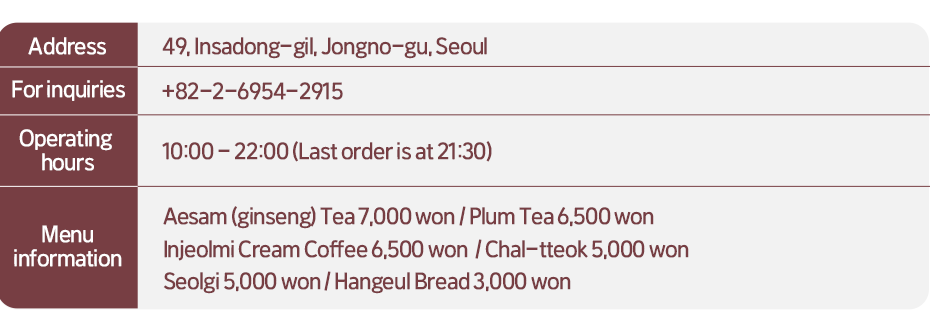
Suggested Itineraries
Wheelchair-friendly One-day Seoul Tour in Traditional Theme
Course Explanation
With as long as a 600-year history, Seoul has been firmly maintaining its position as the capital of Korea since the relocation of the former capital during the Joseon Dynasty, Hanyang, in 1394. Therefore making it easy to find Joseon Dynasty traditions and culture throughout the city.Although Seoul is a rapidly developing global city, the traditional atmosphere intensifies especially in the inner district of the four main gates, which was the urban area during the Joseon Dynasty. Let’s begin our travel back in time, shall we?
Namsangol Hanok Village , close to Chungmuro Station, is perhaps the best spot to start our journey. The village has five restored hanoks, once having belonged to members of the yangban (noble class of the Joseon Dynasty) class with the recovered pond and traditional pavilions in the surrounding area, dating back to the late Joseon Dynasty. Insadong , a 10-minute bus ride from Namsangol Hanok Village, has plenty of traditional style restaurants, cafes, and craft shops alongside the main street. And in just a five-minute walk from the northern end of Insadong, there is the Seoul Craft Museum , a museum drawing a bridge between Korean tradition and modernity. These three wheelchair-friendly tourist attractions are sure to satisfy all travelers looking to discover the traditional side of Seoul.
![]()

Located at the northern foot of Namsan Mountain, the Namsangol Hanok Village is a wonderful spot to appreciate traditional culture. Its location is actually significant as well due to the fact that Pil-dong is a well-known neighborhood where scholars once appreciated the arts at the Cheonugak Pavilion by the valley in the summer. Based on the history of the area, Namsangol Hanok Village was then created in 1998 by restoring and relocating the old topography of the valley pond, summer houses, and the five hanok houses throughout the city. The village grew in popularity after the establishment of Seoul Namsan Gugakdang in 2007, the first performance hall specialized in Korean traditional music and performing arts. ?

Namsangol Hanok Village is relatively less well-known than other hanok villages in Seoul, so it is ideal to enjoy a quiet outing. What's more the provided ramps located at each doorway make it more accessible for the travelers with reduced mobility. While visitors make their way around the village, the preserved remnants of what was once the Joseon Dynasty will transport them back through time. To dive into the Korean tradition culture more deeply, the Namsangol Hanok Village offers diverse crafts and first-hand experiences while also organizing numerous events and festivals throughout the course of the year. The artistic performances are held occasionally in the Seoul Namsan Gugakdang. In addition, visitors can enjoy the traditional culture in the immediate vicinity and the beautiful view of Namsan Seoul Tower nearby.

# NamsanTowerView # NSeoulTower # NamsanGugakdang # SeoulHanokVillage # Traditional Culture Experien # UniversalTourismFacility
![]()
Insadong Gourmet Tour
※ All restaurants featured below are wheelchair accessible. .
You're sure to work up an appetite after immersing yourself in the traditional cultural experience at the Namsangol Hanok Village! Jongno-gu, facing Jung-gu where the village is located, is one of Seoul's leading traditional culture and historical locations, and also an area where you can experience a variety of traditional foods. Located in the Jongno-gu District, Insadong is a place where both Korean and overseas tourists visit to experience Korea's culture of old. As expected, there are many traditional tea houses and Korean restaurants serving up a variety of must-try local foods.

The first place to introduce for your gourmet travel is Jinguk Gomtang , located near Anguk Station of subway line 3. This restaurant specializes in hanwoo, or Korean beef, and offers a menu ranging from hanwoo gomtang (oxtail soup) and jinguk gomtang to hanwoo galbitang (beef short rib soup) and hanwoo ilpoom yukgaejang (spicy beef soup), all made using hanwoo broth. The Korean-based condiments, such as red pepper powder and salt, help add a little something special to your meal as well. The most popular menu items are the oxtail soup and beef short rib soup, which require a significantly long cooking time to make the broth just right. In addition, the restaurant offers a variety of Korean dishes, such as doganitang (ox knee soup), budaejjigae (sausage stew), and stone pot bibimbap.

#Wheelchair Accessible Restaurants in Seoul #Seoul Restaurants #Insadong Restaurants #Korean Food #What To Eat In Seoul #Universal Tourism Facility

The next stop on our tour is the caf?, Seolleneun Majung , located on the 1st floor of a culture complex, Anyoung Insadong. It is a perfect place to experience Korean fusion drinks and desserts. It has various options for drinks, such as plum tea, sprout ginseng tea, and a mixed grain powder latte. It also has a variety of delicious desserts that go on to include glutinous-rice cake, steamed-rice cake, and Korean bread. After enjoying Korean-style tea time at Seolleneun Majung, you'll want to stop by Anyoung Insadong. This modern-day shopping and exhibition center has an abundance of places to shop. The entire building is easy to access for wheelchair users and has facilities for people with disabilities.

#Wheelchair Accessible Restaurants in Seoul #Wheelchair Accessible Caf? In Seoul #Seoul Caf? Recommendations #Korean dessert recommendations #Korean tea #Ginseng
Jinguk Gomtang and Seolleneun Majung are Universal Tourism Facilities certified by Seoul Tourism Organization, guaranteeing wheelchair accessibility. Apart from them, there are an unlimited number of places to visit and foods to taste in the Anguk Station area. After enjoying a scrumptious lunch, Insa-dong has a number of shops, hot spots, and hidden gems to explore, so feel free to explore around the neighborhood and let your meal settle in. .

![]()

The Seoul Museum of Craft Art , built by remodeling the old Pungmoon Girls' High School, is located in a symbolic area that inherits the traditions of day passed just as much so as the Namsangol Hanok Village. It is at the center of Jongno-gu, where the Joseon craftsmen, gyeonggongjang, produced and delivered handicrafts to the pavilion during the Joseon Dynasty. Through craftwork, the spiritual succession can be reckoned throughout the Seoul Museum of Craft Art, serving as a sort of linkage between tradition and modernity. There are glass windows throughout the building, enabling visitors to enjoy the scenery of the Anguk-dong neighborhood alongside the display of craftworks.

The craft museum has permanent exhibitions centered around craft history, featuring From Nature to Crafts Artisans - Creators of Craft Heritage; Artisans - Making the Better World; Craft - Opens the Door to Modern Times; and Crafts - a reflection of the Modern times, to name a few. It also has textile craft exhibitions, such as Embroidery in Bloom and Bojagi, Embracing Daily Life. The museum breaks away from the stereotype of formal space and allows you to use your senses by touching the embroidered fabrics and trying the cloth wrappers. A separate educational building has a children's museum and craft village, where you can enjoy exhibitions and experience various fields of craft, such as hardware, clothes, furniture, and dishes, that are easy to understand.

#Seoul Exhibitions #Seoul attractions #Wheelchair accessible #Wheelchair Travel #Museums in Seoul #What to do in Seoul #Things to do in Seoul #Craft Art #Universal Tourism Facility




